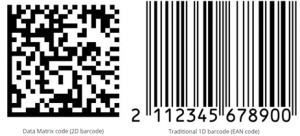Post Date: January 7, 2021
Data Matrix Code: a barcode with special skills
Barcodes can be found everywhere: on food packaging in the supermarket, on shipping packages in logistics and on component parts in industrial factories. Scanning barcode labels with a device is just so much faster than entering information into a system by hand. In addition, it results in fewer errors because machines are simply more reliable in this task.
There are different types of barcodes. They can be divided into:
- one-dimensional (1D) barcodes where data is encoded in one direction only and
- two-dimensional (2D) barcodes encode data in the form of an area across two directions.
One-dimensional barcodes such as EAN codes consist of varying widths and spacings of parallel lines. They are also called linear barcodes.
Just like QR codes, data matrix codes are 2D barcodes. They are usually square in shape and encode information in the form of square black and white dots, forming the so-called timing pattern. It can encode up to 1556 bytes or up to 3116 digits. At one edge you will also see an L-shaped finder pattern consisting of two solid adjacent borders. This part helps scanners to locate and orient the Data Matrix code.
Data matrix codes and their advantages
Data Matrix codes are on the rise and for good reason:
- Higher data density means they occupy less space

- They have a higher fault tolerance of up to 30%
- A much lower contrast is enough for sufficient scan readability
- They can be read in any position (0-360 °)
Due to their ability to encode a large number of characters in an area as small as few millimeters, Data Matrix codes occupy less space than other barcodes. As a result, they are particularly suitable for marking on very small products and round surfaces. Their dimensions are basically only limited by the printer in use. Being very tiny and discreet, Data Matrix codes will not even attract any consumer’s attention. When small in size, they also have the positive side effect of saving consumables such as labels or inks and solvents.
Another great advantage: Data Matrix codes have an integrated method for automatic error correction. Even if up to 30% of the surface is destroyed, powerful algorithms ensure successful decoding!
Data Matrix codes are also much easier in terms of readability: A contrast of only 20% can be sufficient while linear barcodes must have a high contrast of at least 80% for the scanner. This means, for example, more freedom of design with barcode colors which would otherwise be common sources of barcode errors.
To print high-quality linear and 2D barcodes on packaging, Markoprint® is the best alternative on the market. Simply contact AT Information Products to see for yourself. We will make print samples using your actual substrates so you know exactly what to expect. Call (201) 529-0202 or reply here.

